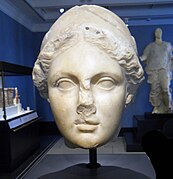February 28th has such an embarrassment of riches when it comes to This Day in History, it’s hard to pick just one: Watson & Crick Discover Chemical Structure of DNA (1953)? Thelonius Monk Makes The Cover of Time Magazine (1964)? Pope Benedict Resigns (2013)? Congress Creates Colorado Territory (1861)? ATF Raids Branch Davidian Compound (1993)? Getty Museum Endowed (1982)? Final Episode of M.A.S.H. Airs (1983)?
I was sorely tempted by that last one. In honor of this week’s Trump-Kim summit in Hanoi – and also because I have an Airbnb guest visiting from Seoul right now – I recently watched the 1970 Robert Altman movie version of M.A.S.H. That’s the one starring Donald Sutherland and Elliott Gould as Hawkeye and Trapper John, not the ’72-’83 TV version with Alan Alda. Although best remembered in the context of the Vietnam War, M.A.S.H. was based on the 1968 Richard Hooker novel about the Korean conflict.
********
In the end, though, I settled on the Getty. Back when we lived in LA and before we had kids, we’d go up there to Malibu and stroll through the Getty’s Greek and Roman antiquities all the time – because we were young and poor, and because it was spectacular and free.

********
And now it becomes clearer why it was free. I guess I kind of knew it at the time: Getty was an oil tycoon, after all. But the details of his bequest, and the museum’s endowment, really are mind-boggling, even by robber baron standards.
The American oil billionaire died in 1976. But legal wrangling over his fortune by his children and ex-wives kept his will in probate until 1982. During those six years, what was a originally a $700 million bequest to the museum nearly doubled. By 2000, the endowment was worth $5 billion – even after the trust spent nearly $1 billion in the 1990s on the construction of a massive museum and arts education complex in Los Angeles.
Furthermore:
In leaving a third of his fortune to the J. Paul Getty Museum, his only stipulation was that the fortune be used “for the diffusion of artistic and general knowledge.” This gave the museum extraordinary freedom – an unusual legacy from a man who in his life had sought absolute control over his affairs. The laws governing trusts, however, indicate that the museum must spend 4.25 percent of its endowment three out of every four years in order to retain its tax-exempt status. In the first year after its endowment, that figure equaled $54 million. Today the amount the museum must spend three out of four years is more than $200 million. The J. Paul Getty Museum’s greatest challenge, therefore, is finding enough art and culture to buy – but not too much that other museums accuse the Getty of hoarding the world’s masterpieces.
For an art museum, that’s a nice problem to have.
********



They can purchase my Barry Bonds baseball for an almost give-a-way sum of 2.3 million. I might even be persuaded to go 2 mil.